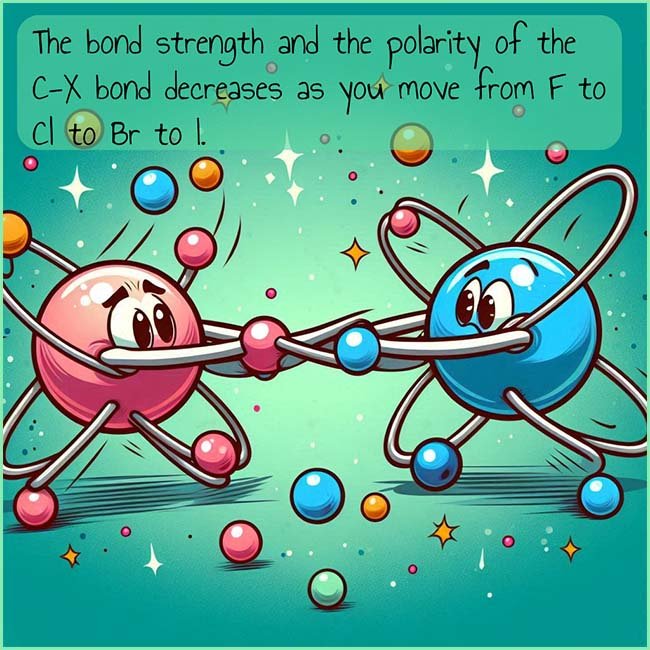
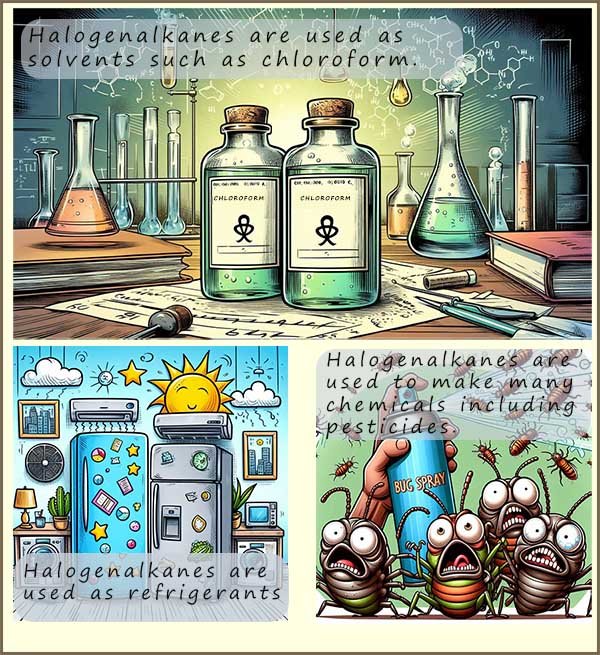
The
halogenalkanes
or haloalkanes form a homologous series of organic compounds with the general formula
CnH2n+1X; where X is one of the halogens
(F, Cl, Br or I). Halogenalkane have various everyday uses, such as in refrigerants in air conditioners and refrigerators, fire extinguishers (halons for fire suppression) and as solvents (e.g. chloroform in cleaning agents). They also play a role in the synthesis of many pharmaceuticals and pesticides. However due to environmental concerns like ozone depletion many halogenalkane especially CFCs and halons which used to be found in fire extinguishers have been phased out and replaced by more environmentally friendly compounds.
The C-X bond in a halogenalkane is a polar bond with the carbon atom
bearing a slight
positive charge (δ+) and
the halogen having a slight negative charge (δ-). The partial positive
charge on the carbon atom attached to the
halogen makes it vulnerable to attack by electron rich species; that is nucleophiles. A mechanism to show one possible way in which a nucleophile (Nu) can attack a carbocation in a halogenalkane is shown below:

In the diagram shown below a nucleophile (Nu)
uses its lone pair of electrons to form a
covalent bond to the
carbon atom attached directly to the bromine atom (the halogen) in a molecule of bromomethane and at the same time
the carbon-bromine bond breaks and a bromide ion (Br-) leaves, for this reason it is often referred to as the leaving group. The end result
is that the bromine atom is replaced or
substituted by the nucleophile, this is
nucleophilic substitution.
 The two most common reactions types that halogenalkanes readily undergo are nucleophilic
substitution and elimination reactions. This page will cover only substitution reactions click the link above if you would like to visit the page on elimination reactions.
The two most common reactions types that halogenalkanes readily undergo are nucleophilic
substitution and elimination reactions. This page will cover only substitution reactions click the link above if you would like to visit the page on elimination reactions.
In a nucleophilic substitution reaction the halogen atom is replaced or substituted with another atom or group for example:
The way in which a halogenalkanes will react with a nucleophile can in part be down to their structure. That is whether they are primary, secondary or tertiary halogenalkanes. So let us start by looking at some structural isomerism involving halogenalkanes. The image below shows two primary halogenalkane molecules. In a primary halogenalkane molecule the carbon atom attached to the halogen atom (X) will have one alkyl group and two hydrogen atoms attached to it. The last molecule in the image below is simply a methane molecule where one of the hydrogen atoms has been replaced by a halogen, in this case an iodine atom, simple halogenalkane molecules such as this where the carbon atom attached to the halogen is bonded to only hydrogen atoms are called methyl halogenalkanes. Two primary halogenalkane and a methyl halogenalkane are shown in the image below:
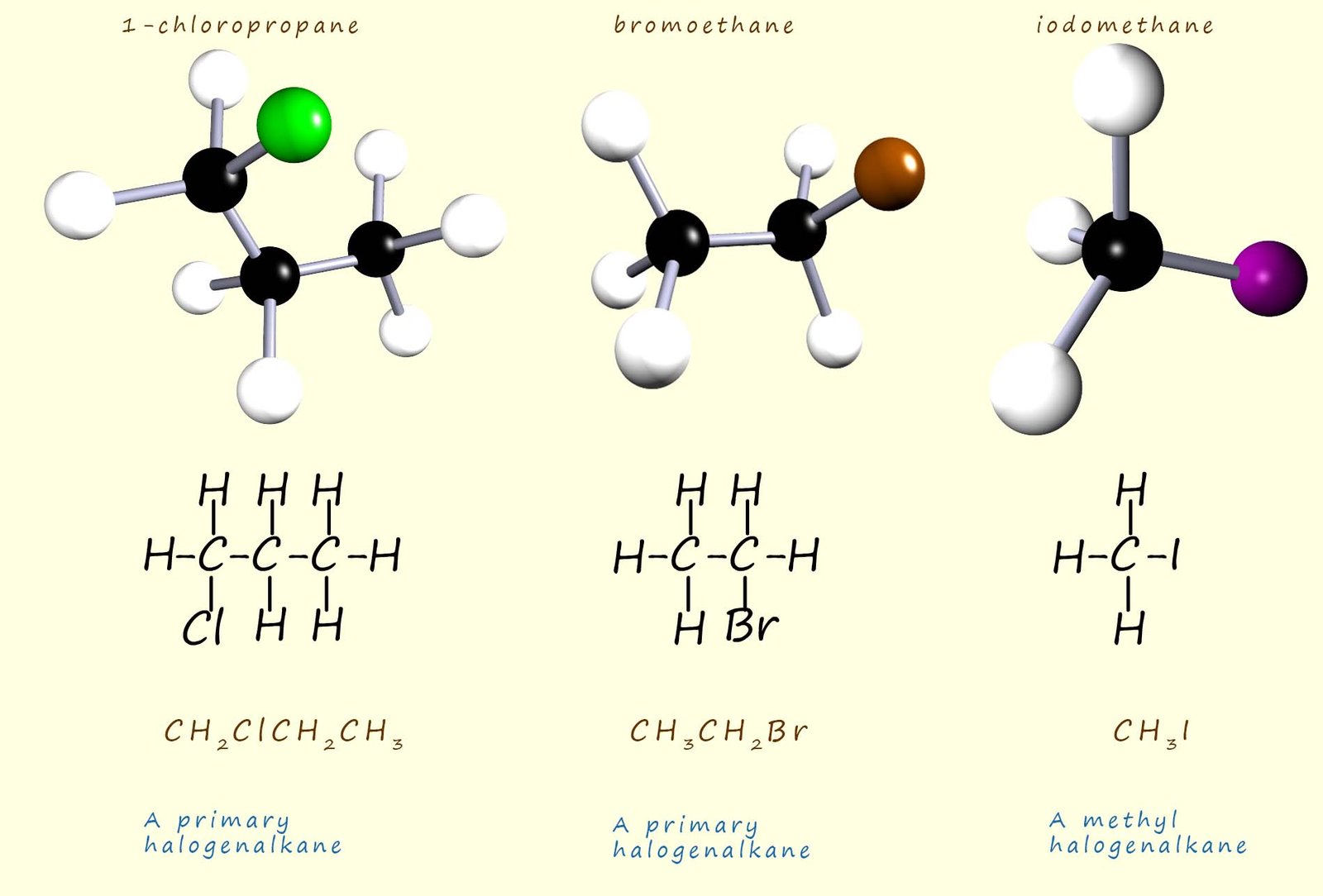
In a secondary halogenalkane molecule the carbon atom joined directly to the halogen will have two alkyl groups and one hydrogen atom attached to it; two examples of secondary halogenalkane molecules are shown below:


The image opposite shows 2-chloro-2methylpropane, a tertiary halogenalkane. In a tertiary halogenalkane molecule the carbon atom attached to the halogen has three alkyl groups directly attached to it; this means that there are no hydrogen atoms attached.
The halogens being electronegative elements means that the C-X bond in the halogenalkane molecules will be a polar one, with the carbon atom in the C-X bond having a partial positive charge (δ+) and the halogen atom having a partial negative charge (δ-). A nucleophile is an electron rich species now nucleophiles can be neutral molecules or ions with lone pairs of electrons which they can donate to an electron deficient molecule/atom (electrophiles); such as the carbon atom in a C-X bond. Examples of common nucleophiles were mentioned above but include hydroxide ions (OH-), cyanide ions (CN-), ammonia (NH3) and water (H2O). All these molecules whether charged or neutral are able to act as nucleophiles simply because they have lone pairs of electrons.
The nucleophilic substitution reactions that halogenalkanes undergo can follow one of two different mechanisms or routes. These mechanisms are called SN1 and SN2. This is short for substitution nucleophilic unimolecular and substitution nucleophilic bimolecular. The mechanism, either the SN1 or SN2 that is followed by the halogenalkane when it reacts with a nucleophile will depend on whether it is a primary, secondary or tertiary halogenalkane.
The image below shows the hydroxide ion (OH-) using one of its lone pairs of electrons to attack the δ+ carbon atom in bromomethane molecule to form the alcohol methanol and a bromide ion (Br-). Now at any given temperature and concentration of the hydroxide ion and the bromomethane the reaction occurs at a certain rate. If we were to say double the concentration of the hydroxide ion then the rate of reaction would also double. Similarly if we double the concentration of the bromomethane then the rate of reaction also doubles. This tells us that the rate of reaction depends on the concentration of both starting reagents; that is it is a second order reaction. The rate of the reaction will change if we alter the concentration of either the hydroxide ion or the bromomethane.

The mechanism put forward to explain this observation is called the SN2, substitution nucleophilic bimolecular. The main features of this mechanism are outlined in the image below and can be broken down into a number of steps:
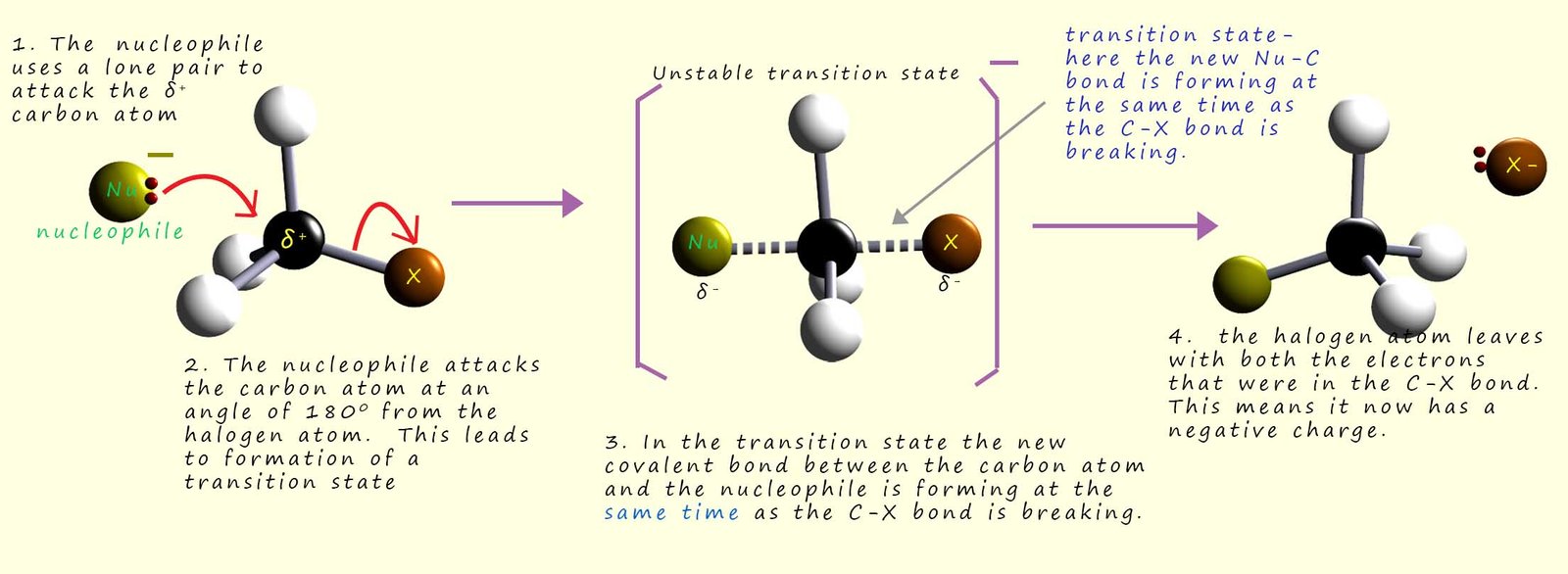
There are a number of factors that affect how quickly these SN2 reactions proceed, one of the most
obvious factors is anything which can block or at least slow or hinder the
incoming nucleophile as it attacks the δ+
carbon atom in the C-X bond is perhaps the most obvious. Since the incoming nucleophile
(Nu) needs
to approach the
δ+ Carbon atom at an angle of 1800 to the leaving nucleophile then
any large bulky groups attached to the carbon atom will slow its
approach or even block it.
In the example given above the δ+ carbon
atom
in the C-X is bonded to three very small hydrogen atoms; what would happen to the
rate of the reaction if one of these hydrogen atoms was replaced by a larger
group such as a methyl group (-CH3) or an ethyl group (-C2H5) or even larger
groups? Well as you might expect as the groups become larger they do
indeed block the incoming nucleophile and slow the
reaction rate. This is summarised in the diagram below which starts with a methyl halogenalkane molecule which undergoes a rapid SN2 reaction and the final image shows a tertiary halogenalkane which does not undergo a SN2 reaction but instead reacts via a SN1 reaction mechanism.
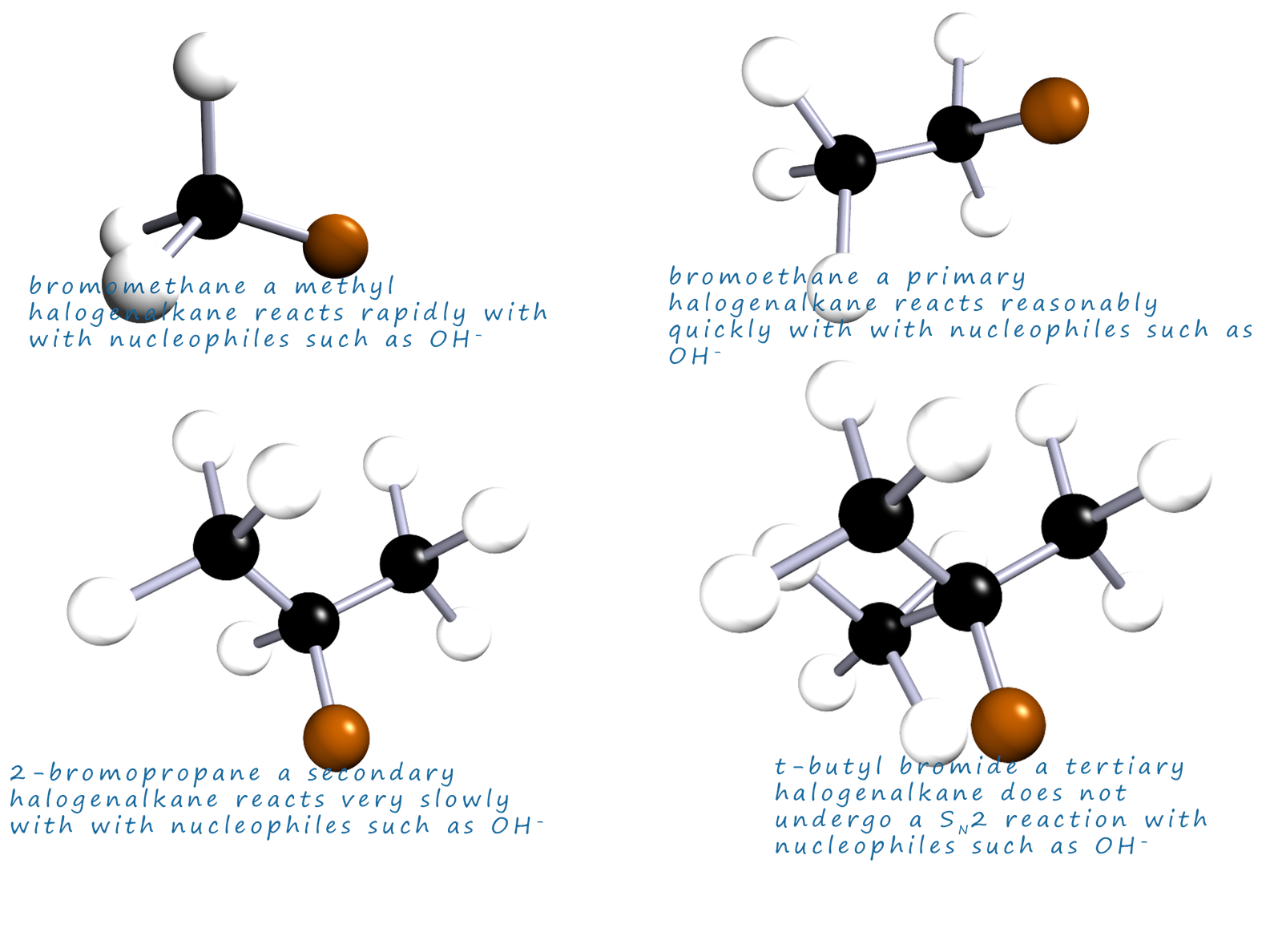
Nucleophilic substitution reactions involving primary halogenalkanes readily take place by an SN2 mechanism; however as the size of the groups attached to the carbon atom bonded to the halogen increase the rate of reaction slows down simply due to the fact that these larger groups block the incoming nucleophile from approaching at 1800. Secondary halogenalkanes have two alkyl groups attached to the carbon bonded to the halogen, here these two groups are more effective at blocking the incoming nucleophile and so secondary halogenalkanes react slower than primary halogenalkanes. What about tertiary halogenalkanes? Well no doubt you will probably have figured out that tertiary halogenalkanes do not react with nucleophiles by a SN2 mechanism. We can summarise this as shown below:

So how do tertiary halogenalkanes react with nucleophiles? The mechanism which has been suggested for these reactions involving tertiary halogenalkanes is called a SN1 reaction (substitution nucleophilic unimolecular). For example if we use 2-bromo-2-methylpropane as an example of a tertiary halogenalkane (as shown above) then in its reaction with a nucleophile the rate of reaction depends only on the concentration of the halogenalkane and NOT the nucleophile. This is different from the SN2 mechanism where the reaction rate depends on both the concentration of the nucleophile and the halogenalkane. The mechanism for the SN1 is outlined below. The reaction of tertiary halogenalkanes occurs in two steps:
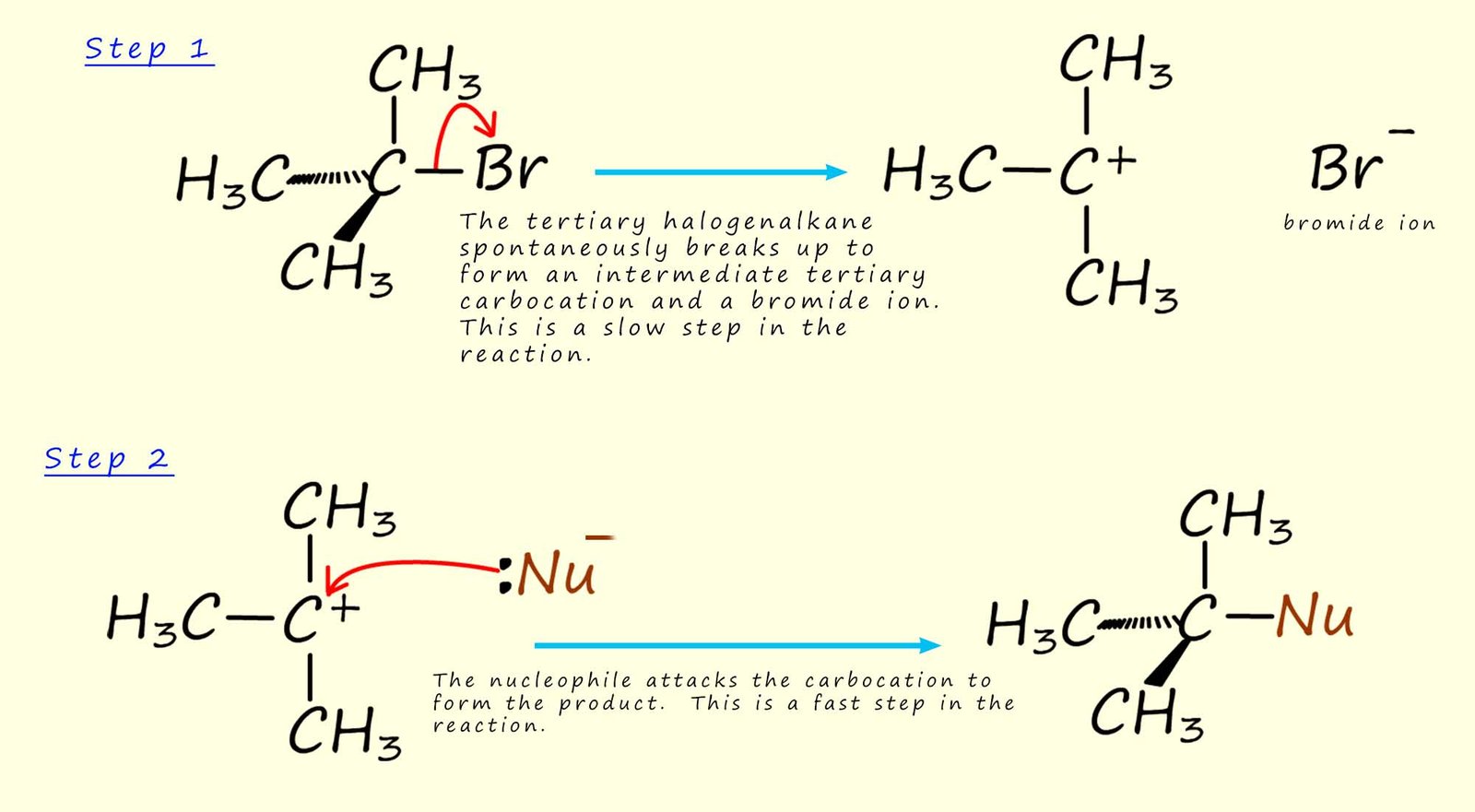
As you move down group 7 from the very electronegative fluorine to the much less electronegative iodine the polarity of the carbon halogen bond will decrease and so the electron deficient carbon atom is less likely to be attacked by a nucleophile.

Based on this decrease in bond polarity you would expect fluoroalkanes to react quickly with the rate of reaction decreasing from fluoroalkanes to chloroalkanes to bromoalkanes with iodoalkanes reacting slowest.
There are a number of factors which affect the strength of the C-X bond but the general trend is bond strength decreases as you move from F to Cl to Br to I the bond strength decreases. This is mainly because the bond length increases due to the larger atomic size of the halogen and longer bonds generally mean weaker bonds, this is outlined in the image below:

Of the two factors it is the strength of the the C-X bond and not the polarity of the bond which has the major effect on the rate of reaction of the halogenalkanes and we can say that the rates of reaction of halogenalkanes follow the pattern:
iodoalkanes > bromoalkanes > chloroalkanes > fluoroalkanes
